Mark Van der Merwe
This&That: Language-Gesture Controlled Video Generation for Robot Planning
Jul 08, 2024Abstract:We propose a robot learning method for communicating, planning, and executing a wide range of tasks, dubbed This&That. We achieve robot planning for general tasks by leveraging the power of video generative models trained on internet-scale data containing rich physical and semantic context. In this work, we tackle three fundamental challenges in video-based planning: 1) unambiguous task communication with simple human instructions, 2) controllable video generation that respects user intents, and 3) translating visual planning into robot actions. We propose language-gesture conditioning to generate videos, which is both simpler and clearer than existing language-only methods, especially in complex and uncertain environments. We then suggest a behavioral cloning design that seamlessly incorporates the video plans. This&That demonstrates state-of-the-art effectiveness in addressing the above three challenges, and justifies the use of video generation as an intermediate representation for generalizable task planning and execution. Project website: https://cfeng16.github.io/this-and-that/.
Integrated Object Deformation and Contact Patch Estimation from Visuo-Tactile Feedback
May 23, 2023



Abstract:Reasoning over the interplay between object deformation and force transmission through contact is central to the manipulation of compliant objects. In this paper, we propose Neural Deforming Contact Field (NDCF), a representation that jointly models object deformations and contact patches from visuo-tactile feedback using implicit representations. Representing the object geometry and contact with the environment implicitly allows a single model to predict contact patches of varying complexity. Additionally, learning geometry and contact simultaneously allows us to enforce physical priors, such as ensuring contacts lie on the surface of the object. We propose a neural network architecture to learn a NDCF, and train it using simulated data. We then demonstrate that the learned NDCF transfers directly to the real-world without the need for fine-tuning. We benchmark our proposed approach against a baseline representing geometry and contact patches with point clouds. We find that NDCF performs better on simulated data and in transfer to the real-world.
Learning the Dynamics of Compliant Tool-Environment Interaction for Visuo-Tactile Contact Servoing
Oct 07, 2022



Abstract:Many manipulation tasks require the robot to control the contact between a grasped compliant tool and the environment, e.g. scraping a frying pan with a spatula. However, modeling tool-environment interaction is difficult, especially when the tool is compliant, and the robot cannot be expected to have the full geometry and physical properties (e.g., mass, stiffness, and friction) of all the tools it must use. We propose a framework that learns to predict the effects of a robot's actions on the contact between the tool and the environment given visuo-tactile perception. Key to our framework is a novel contact feature representation that consists of a binary contact value, the line of contact, and an end-effector wrench. We propose a method to learn the dynamics of these contact features from real world data that does not require predicting the geometry of the compliant tool. We then propose a controller that uses this dynamics model for visuo-tactile contact servoing and show that it is effective at performing scraping tasks with a spatula, even in scenarios where precise contact needs to be made to avoid obstacles.
Visuo-Tactile Transformers for Manipulation
Sep 30, 2022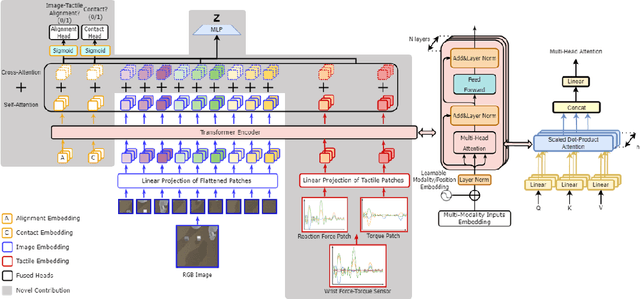
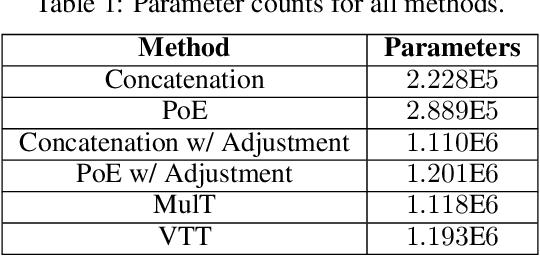
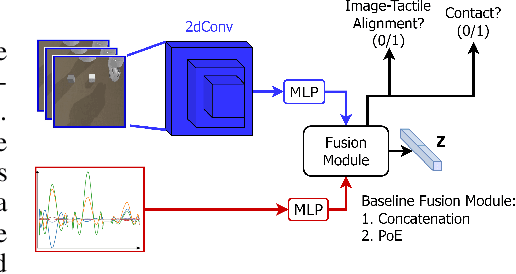
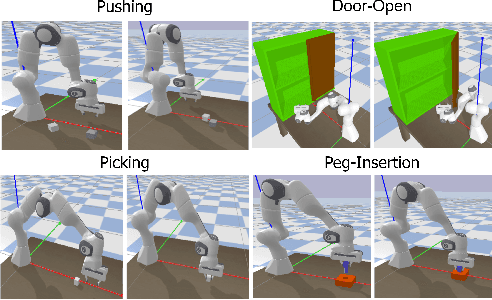
Abstract:Learning representations in the joint domain of vision and touch can improve manipulation dexterity, robustness, and sample-complexity by exploiting mutual information and complementary cues. Here, we present Visuo-Tactile Transformers (VTTs), a novel multimodal representation learning approach suited for model-based reinforcement learning and planning. Our approach extends the Visual Transformer \cite{dosovitskiy2021image} to handle visuo-tactile feedback. Specifically, VTT uses tactile feedback together with self and cross-modal attention to build latent heatmap representations that focus attention on important task features in the visual domain. We demonstrate the efficacy of VTT for representation learning with a comparative evaluation against baselines on four simulated robot tasks and one real world block pushing task. We conduct an ablation study over the components of VTT to highlight the importance of cross-modality in representation learning.
Machine Vision based Sample-Tube Localization for Mars Sample Return
Mar 17, 2021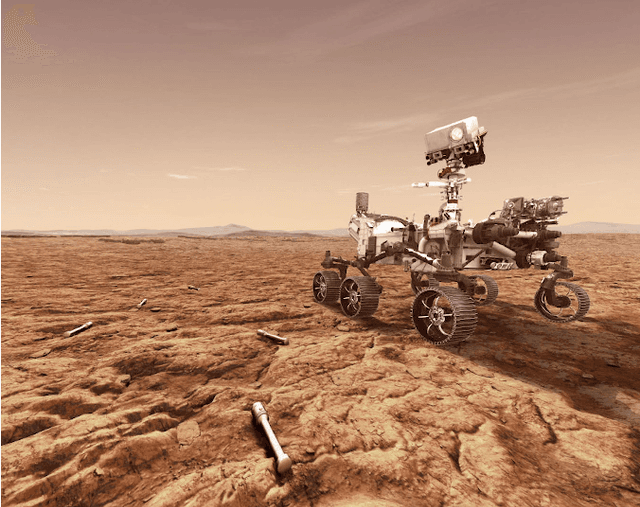

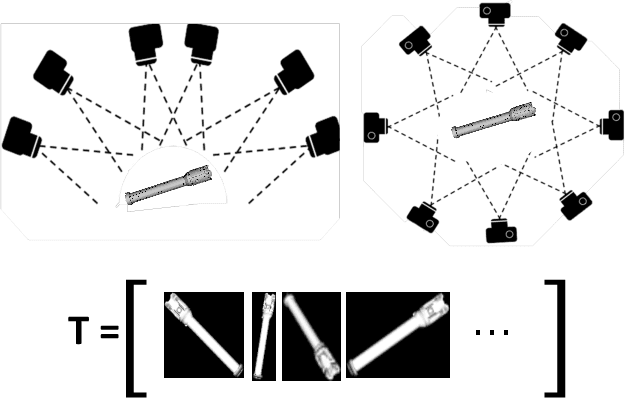

Abstract:A potential Mars Sample Return (MSR) architecture is being jointly studied by NASA and ESA. As currently envisioned, the MSR campaign consists of a series of 3 missions: sample cache, fetch and return to Earth. In this paper, we focus on the fetch part of the MSR, and more specifically the problem of autonomously detecting and localizing sample tubes deposited on the Martian surface. Towards this end, we study two machine-vision based approaches: First, a geometry-driven approach based on template matching that uses hard-coded filters and a 3D shape model of the tube; and second, a data-driven approach based on convolutional neural networks (CNNs) and learned features. Furthermore, we present a large benchmark dataset of sample-tube images, collected in representative outdoor environments and annotated with ground truth segmentation masks and locations. The dataset was acquired systematically across different terrain, illumination conditions and dust-coverage; and benchmarking was performed to study the feasibility of each approach, their relative strengths and weaknesses, and robustness in the presence of adverse environmental conditions.
Rover Relocalization for Mars Sample Return by Virtual Template Synthesis and Matching
Mar 05, 2021

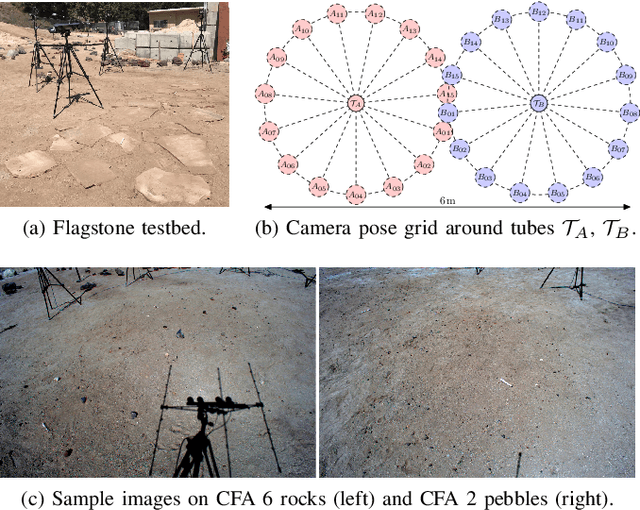
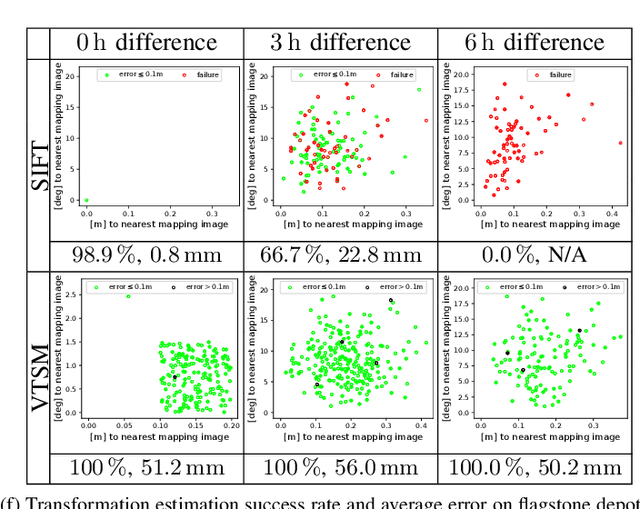
Abstract:We consider the problem of rover relocalization in the context of the notional Mars Sample Return campaign. In this campaign, a rover (R1) needs to be capable of autonomously navigating and localizing itself within an area of approximately 50 x 50 m using reference images collected years earlier by another rover (R0). We propose a visual localizer that exhibits robustness to the relatively barren terrain that we expect to find in relevant areas, and to large lighting and viewpoint differences between R0 and R1. The localizer synthesizes partial renderings of a mesh built from reference R0 images and matches those to R1 images. We evaluate our method on a dataset totaling 2160 images covering the range of expected environmental conditions (terrain, lighting, approach angle). Experimental results show the effectiveness of our approach. This work informs the Mars Sample Return campaign on the choice of a site where Perseverance (R0) will place a set of sample tubes for future retrieval by another rover (R1).
Multi-Fingered Active Grasp Learning
Jun 06, 2020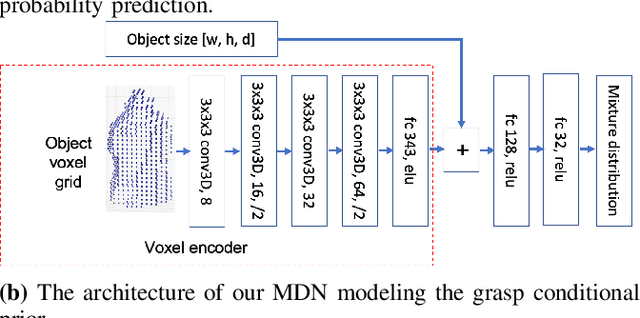
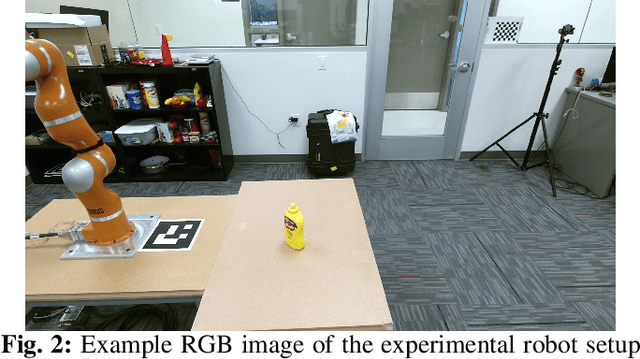
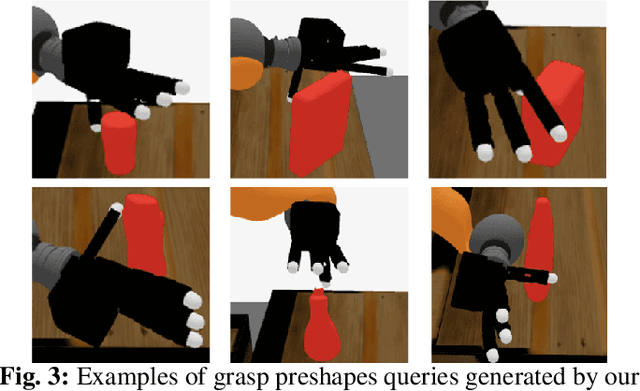

Abstract:Learning-based approaches to grasp planning are preferred over analytical methods due to their ability to better generalize to new, partially observed objects. However, data collection remains one of the biggest bottlenecks for grasp learning methods, particularly for multi-fingered hands. The relatively high dimensional configuration space of the hands coupled with the diversity of objects common in daily life requires a significant number of samples to produce robust and confident grasp success classifiers. In this paper, we present the first active learning approach to grasping that searches over the grasp configuration space and classifier confidence in a unified manner. Our real-robot grasping experiment shows our active grasp planner using less training data achieves comparable success rates with a passive supervised planner trained with geometrical grasping data. We also compute the differential entropy to demonstrate our active learner generates grasps with larger diversity than passive supervised learning using more heuristic data. We base our approach on recent success in planning multi-fingered grasps as probabilistic inference with a learned neural network likelihood function. We embed this within a multi-armed bandit formulation of sample selection. We show that our active grasp learning approach uses fewer training samples to produce grasp success rates comparable with the passive supervised learning method trained with grasping data generated by an analytical planner.
Multi-Fingered Grasp Planning via Inference in Deep Neural Networks
Jan 25, 2020



Abstract:We propose a novel approach to multi-fingered grasp planning leveraging learned deep neural network models. We train a voxel-based 3D convolutional neural network to predict grasp success probability as a function of both visual information of an object and grasp configuration. We can then formulate grasp planning as inferring the grasp configuration which maximizes the probability of grasp success. In addition, we learn a prior over grasp configurations as a mixture density network conditioned on our voxel-based object representation. We show that this object conditional prior improves grasp inference when used with the learned grasp success prediction network when compared to a learned, object-agnostic prior, or an uninformed uniform prior. Our work is the first to directly plan high quality multi-fingered grasps in configuration space using a deep neural network without the need of an external planner. We validate our inference method performing multi-finger grasping on a physical robot. Our experimental results show that our planning method outperforms existing grasp planning methods for neural networks.
Learning Continuous 3D Reconstructions for Geometrically Aware Grasping
Oct 02, 2019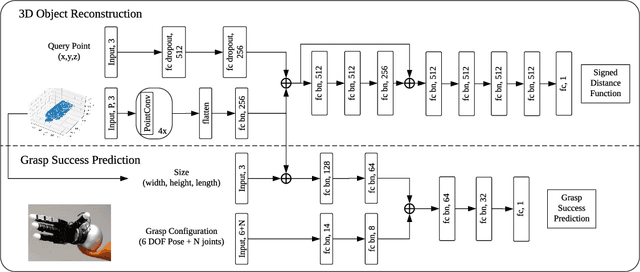
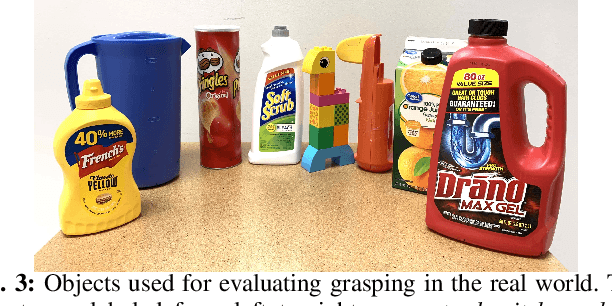

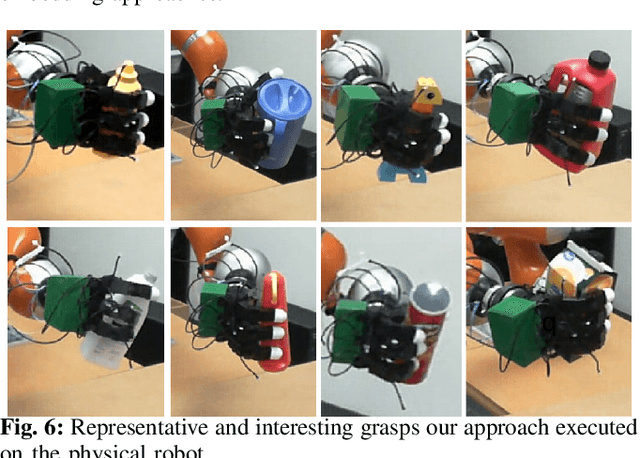
Abstract:Deep learning has enabled remarkable improvements in grasp synthesis for previously unseen objects viewed from partial views. However, existing approaches lack the ability to explicitly reason about the full 3D geometry of the object when selecting a grasp, relying on indirect geometric reasoning derived when learning grasp success networks. This abandons common sense geometric reasoning, such as avoiding undesired robot object collisions. We propose to utilize a novel, learned 3D reconstruction to enable geometric awareness in a grasping system. We leverage the structure of the reconstruction network to learn a grasp success classifier which serves as the objective function for a continuous grasp optimization. We additionally explicitly constrain the optimization to avoid undesired contact, directly using the reconstruction. By using the reconstruction network, our method can grasp objects from a new camera viewpoint which was not seen during training. Our results show that utilizing learned geometry outperforms alternative formulations for partial-view information based on real robot execution. Our results can be found on https://sites.google.com/view/reconstruction-grasp/.
Message Scheduling for Performant, Many-Core Belief Propagation
Sep 24, 2019



Abstract:Belief Propagation (BP) is a message-passing algorithm for approximate inference over Probabilistic Graphical Models (PGMs), finding many applications such as computer vision, error-correcting codes, and protein-folding. While general, the convergence and speed of the algorithm has limited its practical use on difficult inference problems. As an algorithm that is highly amenable to parallelization, many-core Graphical Processing Units (GPUs) could significantly improve BP performance. Improving BP through many-core systems is non-trivial: the scheduling of messages in the algorithm strongly affects performance. We present a study of message scheduling for BP on GPUs. We demonstrate that BP exhibits a tradeoff between speed and convergence based on parallelism and show that existing message schedulings are not able to utilize this tradeoff. To this end, we present a novel randomized message scheduling approach, Randomized BP (RnBP), which outperforms existing methods on the GPU.
 Add to Chrome
Add to Chrome Add to Firefox
Add to Firefox Add to Edge
Add to Edge